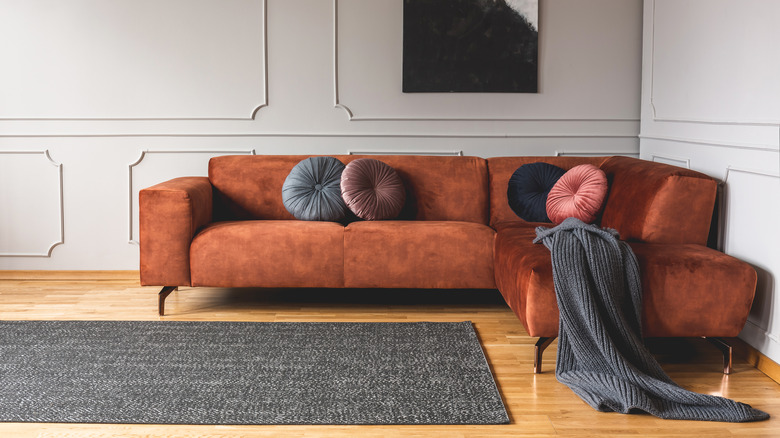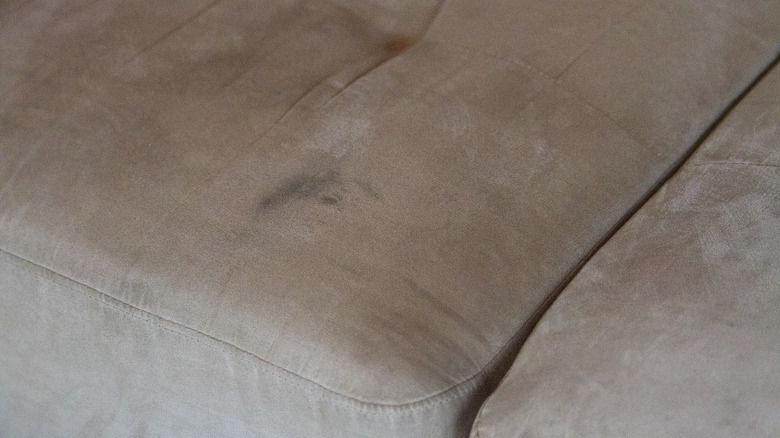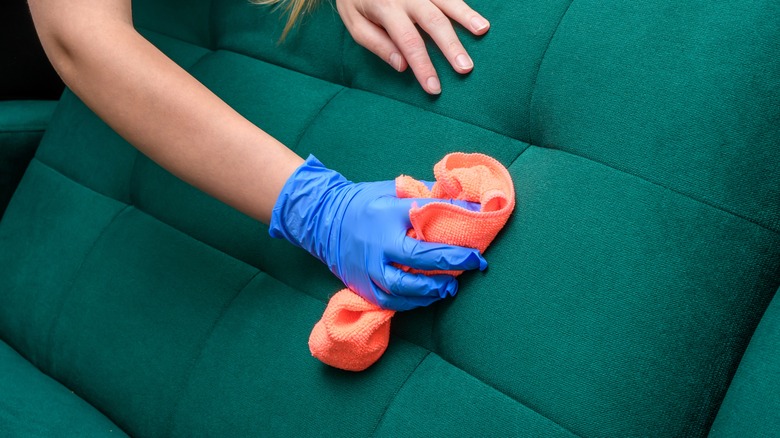The Common Ingredient You Shouldn't Use To Clean A Suede Or Velvet Sofa
When washing anything in our homes, we use water, right? Not exactly. At least in the case of suede or velvet, the situation gets complicated. In fact, they're among the three types of fabric that you shouldn't clean with water — velour is the other, in case you were wondering. Water can actually do more damage than good because, in many cases, it fixes the minute fibers of the fabric in place, potentially leaving a permanent wipe mark. Genuine suede and velvet aren't cheap; you don't want to ruin them. But this effect can happen even with faux textiles. It's likely not in the budget to replace an entire sofa, even one upholstered in imitation fabric, because of a simple cleaning error.
While real velvet and suede may look similar, they're created through very different processes. Velvet is made from thread — traditionally silk thread, though that's rare today — that is looped to create a dense pile, similar to woolen carpet, rather than a weave and waft structure like, say, cotton or linen fabric. The loops are cut, creating strands that stick straight up. They can also be left uncut. Suede, on the other hand, is crafted from the reverse side of a piece of leather, the part that once connected to the body of the animal, typically a lamb. It's much softer to the touch than its air-exposed counterpart. There are also synthetic look-a-like fabrics. For example, synthetic suede is typically made from microfiber polyester and plastic glue.
Water woes explained
Velvet is damage-prone because it's a relatively thin and highly absorbent fabric, as far as upholstery textiles go. This means any spills, including water, soak in fast, leading to stains you can't get out. Be extra careful if you're a velvet couch owner and live in a house or area with hard water. The high mineral content in the water can mar this delicate fabric. Suede, on the other hand, tends to discolor and harden when it comes into contact with larger volumes of water. However, synthetic versions of these fabrics may not respond to water similarly.
If unsure, look on the sofa for a cleaning instruction label or check the care manual. Letters W (Wet) and WS (Wet and Solvent) mean cleaning with water is okay. If you see the letter D (Dry Clean), S (Solvent), or X (Vacuum), don't let water near your precious recliner. A professional service should be the default option if you can't find cleaning information on your piece of suede or velvet furniture — a sofa or otherwise — or if you have any doubts about your cleaning abilities. It's especially important to hire a professional service if you're dealing with antique or vintage fabrics. Is professional cleaning out of your price range? If you've okayed your suede or velvet couch for cleaning with water, as described above, you can clean your sofa yourself. After all, you've mastered the stylish ways to incorporate velvet into your home decor.
If you want to DIY it
Don't disappoint your inner interior designer by neglecting your fuzzy furniture. All you need is patience, a guide (we've got you covered there!), and suitable cleaning solutions and equipment. Cleaning a velvet couch at home requires multiple steps. First, vacuum the entire sofa and check it over carefully for stains. Remove any you find by dabbing at them with a damp cloth. If your couch care label says S, mix 2 tablespoons of baking soda into a small bowl filled with lemon juice and use that. Warning: Test it in a hidden spot first! Alternatively, dusting cornstarch overnight and then vacuuming it may lift stains. Steam the upholstery — this gets rid of wrinkles.
Once dry, gently brush (or, to use official terminology, card) the velvet to get the strands standing upright again and remove any stubborn specks of dust and dirt. Brushing won't harm your sofa: that they're delicate is a velvet furniture myth you should stop believing. Jon-Don sells a wooden velvet brush with aluminum bristles for $26.24, or you can get a professional velvet carding brush for $35.87 from Magic Wand Company. The process for cleaning suede is similar, but there's one crucial difference: don't brush it. Suede doesn't hold up well to heavy handling. Once clean, treat your sofa with a stain-repellent product like RepelWell Upholstery Protect (get a 12-ounce spray bottle for $19.99) or Nanotech Fabric-Shield — a 2-ounce spray bottle is $13.95 on Amazon.


